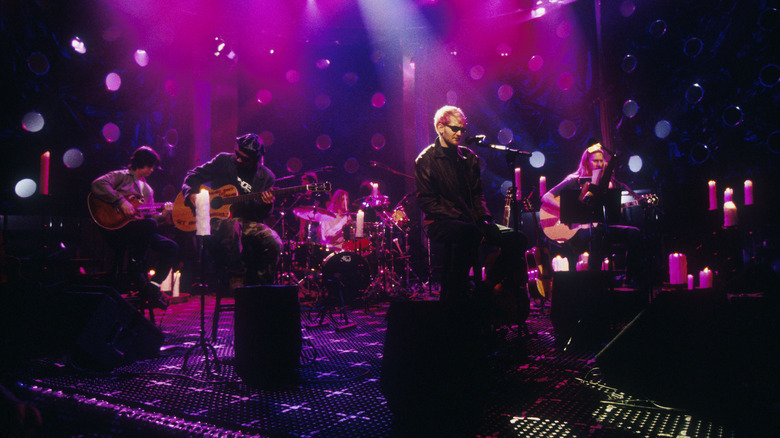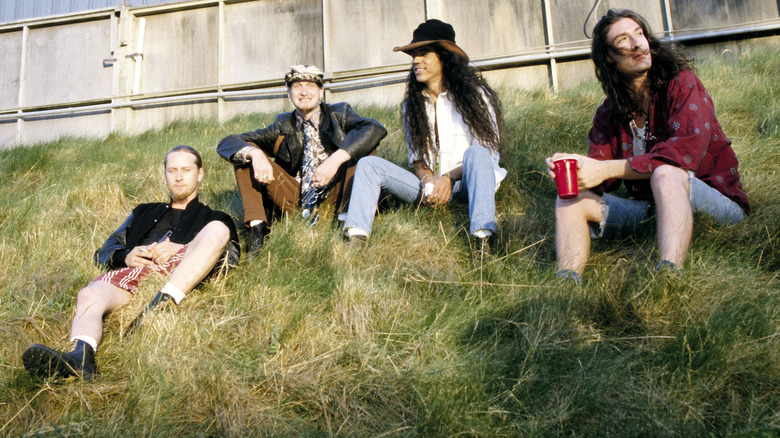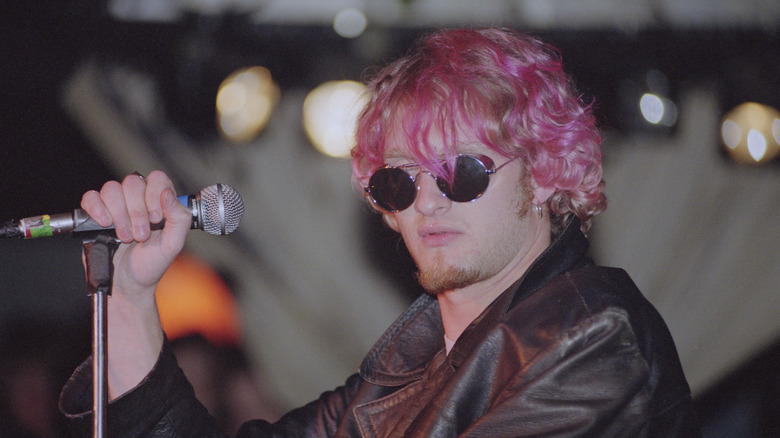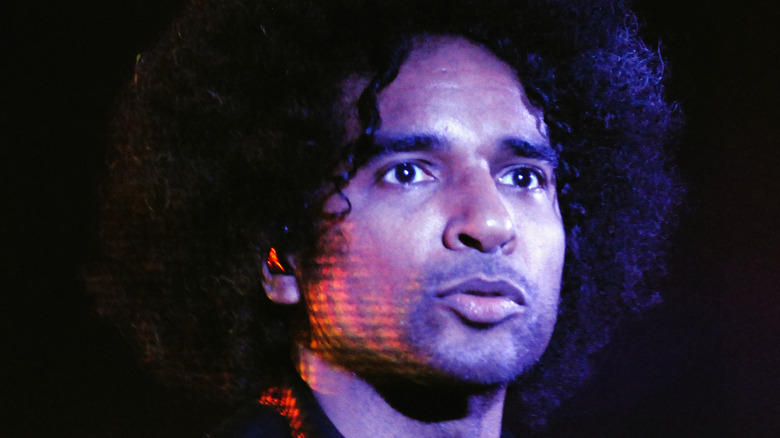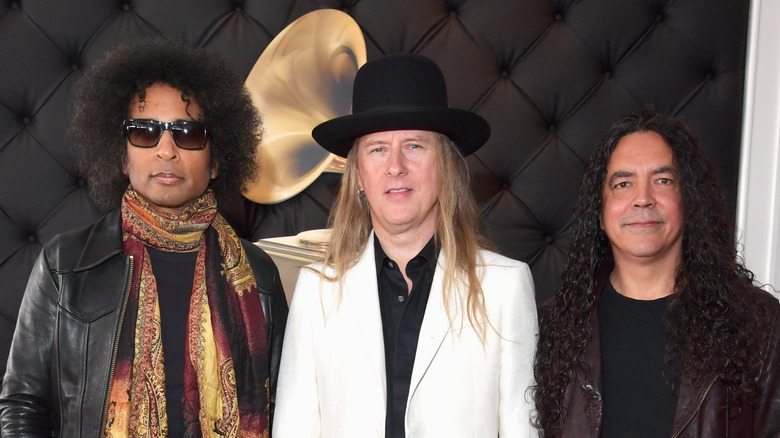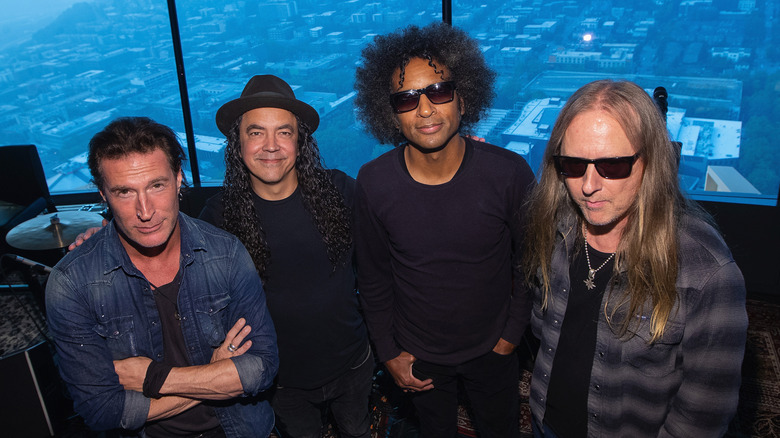The Untold Truth Of Alice In Chains
As a band, Alice in Chains deserves credit for straying away from conventions and establishing its unique identity in a competitive industry. According to All Music, metal was hugely inspiring and helped build the foundation of its music, and the band became a heavyweight in the 1990s.
Alice in Chains were a part of the Seattle music scene, playing live gigs in the Pacific Northwest until they got the opportunity to create a demo and sign with Columbia Records. The label was intrigued by the band and lent its support wholeheartedly, something that helped them get noticed pretty quickly. But while the band did pretty well for itself publicly, behind the scenes, its members tried to deal with differences within the group.
As Alice in Chains gained popularity and carved a niche, the band was dealing with a bunch of things, including addiction, a period of separation and uncertainty, new band members, and more. The journey hasn't been straightforward, but the band remains active even today and is respected for its invaluable contribution to the industry. This is the untold truth of Alice in Chains.
Alice in Chains took some time to figure themselves out
Alice in Chains was the result of a few other projects, and it took the band some time to figure out their act. Their story started with a band called Sleze, which, per All Music, later became known as Alice N' Chains. This group was founded by Layne Staley, who then came across future bandmate Jerry Cantrell. The two hit it off, and, after Alice N' Chains and Cantrell's own band dissolved, Cantrell started another band with Mike Starr and Sean Kinney, while Staley was working with a funk band.
Cantrell and Staley struck a deal: they'd perform in each other's bands and play fair. However, the funk group didn't last, and Staley became a permanent member of the other band, which they named Alice in Chains. According to Rolling Stone, the band's popularity was well earned, and that its members worked really hard to establish themselves in the industry. Cantrell was proud of their work and was also aware of the fact their style was "a little more brooding and introspective." The musician added, "Some stuff grabs you right away; ours is really an acquired taste. It takes a few deep bites to get what it's all about."
Lead vocalist Layne Staley had a unique voice
Alice in Chains frontman Layne Staley was a sensational performer who knew exactly how to captivate his audience and come up with unique sounds. Per the Atlantic, he was in the same league as fellow grunge-scene frontmen Kurt Cobain, Chris Cornell, and Eddie Vedder. But what made Staley stand out was his voice, something that was both vulnerable and powerful at the same time.
Musician Sully Erna, of Godsmack, once commented that he was inspired to sing thanks to Staley. Erna said, "He was single-handedly the guy that got me to start singing... his vocal style in general was so different from anything that anyone was writing that it was so appealing and attractive that you couldn't help but be influenced by it." (via the Atlantic)
Also, Staley's natural talent was obvious by the fact that he wouldn't hesitate to improvise and try new things while recording a song. The fact that he was original was his greatest strength. Guitarist Johnny Bacolas, who worked with the singer in his early days remarked, "Layne had his own thing, and I think that's what was the most appealing about him. He had a very distinctive voice."
Layne Staley met a tragic end
Layne Staley had a lot going for him: he was talented and was making an impact in the music industry with his talent. Unfortunately, there was one thing he could never quite beat: drug addiction.
Far Out Magazine reports that the singer was found dead in his Seattle apartment on April 5, 2002. Investigators concluded that he died of an accidental overdose. In the late 1990s, Staley suffered a major blow when he lost his fiancee, Demri Lara Parrott, whose death was also linked to an overdose.
The singer was heartbroken and didn't take great care of himself. It's believed that he spent a huge chunk of his final years by himself, and even stopped consuming regular food, mostly relying on supplements. He even ended up with gangrene at some point. Staley seemed to know what was coming for him. He told writer Adriana Rubio, "I know I'm near death... I did crack and heroin for years. I never wanted to end my life this way. I know I have no chance. It's too late. I never wanted [the public's] thumbs' up about this f****** drug use." (via Far Out Magazine).
If you or anyone you know is struggling with addiction issues, help is available. Visit the Substance Abuse and Mental Health Services Administration website or contact SAMHSA's National Helpline at 1-800-662-HELP (4357).
Alice in Chains continued after Layne Staley's demise
Layne Staley's demise was a huge blow for his friends and former bandmates, but for several years before the lead singer's death, the band had been on hiatus and the bandmates estranged. According to the A.V. Club, at the time of Staley's death, neither Alice in Chains drummer Sean Kinney nor guitarist Jerry Cantrell had spoken to the singer for more than two years.
However, according to Vice, Alice in Chains made a comeback in 2006, with William DuVall taking Staley's place. Their first recorded album, however, was only released in 2009 and was called "Black Gives Way to Blue." Cantrell felt reasonably confident about Alice in Chains at this point, telling Vice, "We weren't nervous because we felt the same way we felt every time we put a record out. We knew it was good. We were continuing on. We were reinventing ourselves. Those are all elements of everybody's life."
He added that they definitely didn't want to give up, and were thankful for the new iteration being mostly embraced by their fans. However, this was something that happened gradually. In the days following Staley's death, the band was too shaken up and didn't feel like performing. They considered doing something private as a tribute to Staley, but things were uncertain and broken until 2005, when the band got together to play at a benefit concert for victims of the previous year's major tsunami. Cantrell said, "...that was a really heavy night to stand up there without Layne and play those tunes. It was fu***** heartbreaking. But it was also very triumphant and cathartic." (via Vice).
New frontman William DuVall received a lot of support
Most fans were happy to see Alice in Chains back in action after their long break from the industry. For new singer William DuVall, being a part of the band was a huge responsibility. But, Loudwire reports, he was encouraged by Staley's family to perform. Layne Staley's dad, Phil said, "William has done a wonderful job and I couldn't be prouder that the group is still carrying on. I love all those guys, love them ... we are family."
DuVall was incredibly touched by the support he received. He was also grateful for the fact that fans welcomed him in their own way. He recalled singing with the audience members at a concert and said, "That's such an unbelievably beautiful feeling ... All you can do in the moment is kind of be in the moment, so you're not really thinking about how profound this is." The singer told Kerrang! that "Layne was doing the same thing that all of us try to do as songwriters: you're trying to tell your truth, and hopefully it strikes a chord with somebody else... it really transcends space and time. And death."
Jerry Cantrell has released solo albums
Per Kerrang!, guitarist Jerry Cantrell decided to start recording music alone when Alice in Chains was relatively inactive as a band. He explained, "The two [solo] records I was able to make at the turn of the century, to quote the Bee Gees, were in a period when [Alice In Chains] weren't doing a lot as a band, so I had the opportunity."
Cantrell explained that he likes to sit with ideas for extended periods before he turns them into songs. He added that he could guess fairly accurately what his listeners would think about the songs. He said, "I've been lucky enough to have an ear for when [a piece of music] is important or really good. If it strikes me that way, I can infer from experience that if it's hitting me that way it'll probably hit a few other people that way too."
Dirt was influenced by the LA riots
Most die-hard fans of Alice in Chains will be able to talk at length about one album in particular: "Dirt." According to Revolver Magazine, the album resonated with listeners pretty quickly and was a massive hit, despite the fact that it was intense in more ways than one. The songs were recorded during a difficult period: the 1992 riots in Los Angeles.
Guitarist Jerry Cantrell once remarked that it was hard to ignore what was happening outside while they were creating the album. He recalled, "I was actually in a store buying some beer when some guy came in and started looting the place. I also got stuck in traffic and saw people pulling other people out of their cars and beating the crap out of them." He added that it was a pretty scary experience and that it "definitely affected the overall feel of the album."
Alice in Chains was passionate about the grunge scene
As pointed out by Vice, Alice in Chains introduced new sounds to the public and its members were not afraid to take risks with their music. They brought a combination of metal, hard-hitting lyrics, strong vocals, and unforgettable tunes. In a matter of five years, the band had their listeners hooked: they managed to work on three albums and released hit singles. Somewhere along the way, they even experimented with acoustic music. Jerry Cantrell told Vice, "Just artistically to be able to widen the field that you're able to operate in so early in our career was very important."
Before grunge became a genre that was recognized by the mainstream, Alice in Chains was starting a movement of their own with like-minded musicians. Cantrell explained that the collective energy in 1990s Seattle was hard to ignore. He said, "What was happening in our hometown — it was already special to us and we could already feel the energy — and it was starting to kinda spill out across the country." At some point, they could feel that they were in sync with those who were trying something similar. As Cantrell said, "You started to feel a buzz about it and it was like, 'Shit, I think we might be doing the right thing here; this is kinda cool.'"
Jar of Flies has an interesting backstory
Some Alice in Chains songs were inspired from the most unlikely things and events from the band members' lives. One of the strongest examples is the album "Jar of Flies." In an interview with Hit Parader, Layne Staley explained the title. "It came from a science experiment Jerry Cantrell did when he was in the third grade," he said.
This is how things went down: Cantrell basically had two jars of flies. While one of them contained insects that had an abundance of food to feast on, the other jar had flies that were surviving on very little and were malnourished. Somehow, the jar with the flies that were being overfed was the one with the tragic ending: all the flies perished because of overpopulation. Meanwhile, the underfed flies stayed resilient and survived for an extended period. Staley said, "I guess there's a message in there somewhere. Evidently that experiment had a big impact on Jerry."
Alice in Chains bassist Mike Starr passed away in 2011
In 2011, Alice in Chains' former bassist and founding member Mike Starr passed away at 44 years old. According to the Guardian, Starr had battled addiction for years, and had left the band after the release of "Dirt." Rolling Stone reports that he later said he was asked to leave because of his addiction.
While Starr mostly kept a low profile after Alice in Chains, he did participate in a reality show on VH1 called "Celebrity Rehab." As per Vulture, he wasn't entirely comfortable with the cameras during the show, and was heard saying, "I mean, I'm sound asleep, I wake up, and there's a f****** camera on me. What the f*** is that?"
As reported by the Guardian, Starr got into the trouble with the police weeks before he died for possessing unauthorized prescription pills and for having an outstanding warrant that was related to drugs. As per Rolling Stone, Starr spoke about being disturbed by Layne Staley's demise and was under the impression that he was the last person to see the singer before he died.
If you or anyone you know is struggling with addiction issues, help is available. Visit the Substance Abuse and Mental Health Services Administration website or contact SAMHSA's National Helpline at 1-800-662-HELP (4357).
Jerry Cantrell has also struggled
Jerry Cantrell may come across as being level-headed, but he has had his own demons to deal with. According to Kerrang!, when Alice in Chains got a chance to perform on "MTV Unplugged" in 1996, the band members knew that this could be a great opportunity to showcase their talent to the world. Cantrell said, "Boiling it down reveals the heart of the song, without all the bells and whistles, and if it still hits in that environment then you did good."
But Cantrell couldn't help but feel overwhelmed as they got closer to the performance, starting to feel really unwell. Cantrell later said that it was a combination of the mental, physical, and emotional challenges that came with being a part of a band. Performing gave him some respite from his troubles. He said, "When the lights went green, the cameras started rolling, my body gave me some adrenaline and dopamine I needed to get through it."
If you or someone you know is struggling with mental health, please contact the Crisis Text Line by texting HOME to 741741, call the National Alliance on Mental Illness helpline at 1-800-950-NAMI (6264), or visit the National Institute of Mental Health website.
Alice in Chains is dark, but with a sense of humor
There's no denying that listening to Alice in Chains can often be a hard-hitting and super intense experience. But that doesn't mean that its band members can't laugh at themselves. Bassist Mike Inez told Loudwire that they simply use music as an outlet to express their feelings. He said, "We're just blessed by music and so grateful for everything, especially the fans. We couldn't do these albums and tours if nobody wanted to listen to us."
The article noted that Inez and his band mates don't come across as intense in real life and are actually fairly light-hearted. Inez didn't contest that point. A Rolling Stone review also points out that the band's sense of humor can even be found in some of their songs, giving the example of the "ultracatchy" song, "God Am," which it describes as featuring "playfully sacrilegious double-entendre."
Jerry Cantrell values his privacy
In a world that's often hooked to social media, the members of Alice in Chains prefer to take a slightly different approach. As per Jerry Cantrell, they don't like being too active on social media (via Vice). When he was asked to voice his opinions on musicians being too involved online, Cantrell said, "I don't want any part of it. I think we all do a lot better to know there's no putting the genie back in the bottle so I'll just stay out of it. I don't have a Facebook account, I don't tweet."
The band is kind of old school and likes to maintain a certain air of mystery. Cantrell added that he understands that their attitude doesn't work for the many other musicians who prefer using social media to connect with their fans. He said, "I'm not gonna say it doesn't work for someone else ... obviously a lot of people on the planet are f****** involved with it so that's just my particular take on it."
